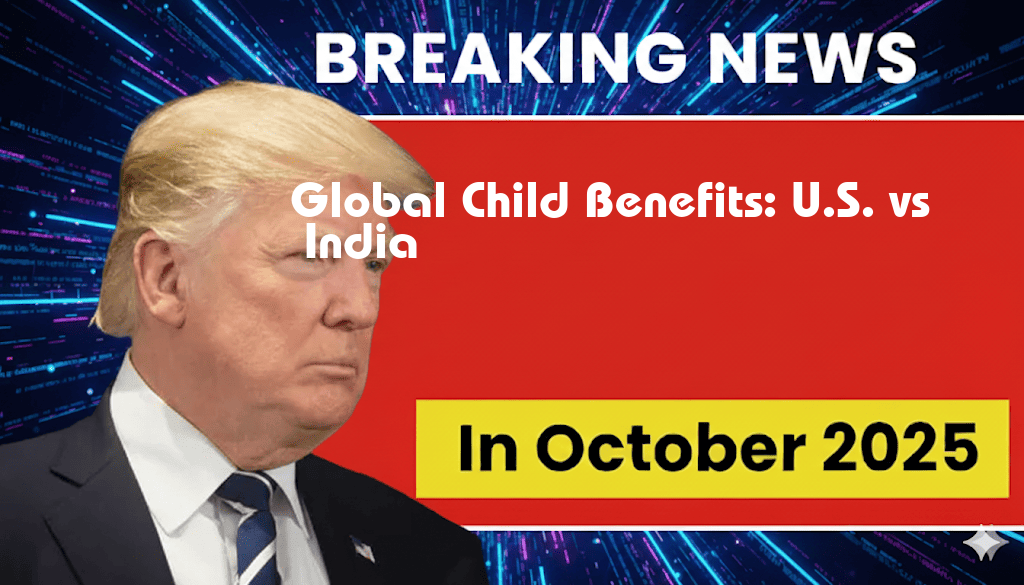

The global landscape of child benefits reveals stark contrasts, particularly when comparing the United States and India. In the U.S., families can claim a $2,200 credit for each qualifying child under the Child Tax Credit (CTC), while in India, parents can access a substantial ₹1,65,000 (approximately $2,000) through various government schemes aimed at improving child welfare. As countries grapple with the challenges of child poverty and education, these benefits serve as critical lifelines for many families. This article explores the differences in child benefit schemes in these two nations, examining the implications for families and the broader economy.
Understanding Child Benefits in the U.S.
The Child Tax Credit (CTC) in the United States is a significant source of financial support for families with children. Established to alleviate poverty and encourage family growth, the CTC was enhanced under the American Rescue Plan in 2021, temporarily increasing the benefit amount.
Key Features of the U.S. Child Tax Credit
- Benefit Amount: Currently, families can receive up to $2,200 per child under age 17.
- Qualification: Eligibility is determined by income thresholds, with phases out starting at $200,000 for single filers and $400,000 for joint filers.
- Refundability: The credit is partially refundable, allowing lower-income families to receive some benefits even if they do not owe taxes.
Child Benefits in India: A Closer Look
In India, the government has implemented various initiatives to support child welfare, including direct cash transfers, nutrition programs, and educational grants. The total potential benefit that parents can access amounts to approximately ₹1,65,000. This figure reflects the cumulative impact of different schemes aimed at enhancing child health and education.
Key Features of Child Benefits in India
- Direct Cash Transfers: The Indian government has launched several direct benefit transfer schemes that provide financial assistance to families.
- Nutrition Programs: Initiatives like the Mid-Day Meal Scheme ensure children receive adequate nutrition in schools.
- Educational Grants: Various scholarships and grants are available to support children’s education from primary to higher levels.
Comparative Analysis of Benefits
| Aspect | United States | India |
|---|---|---|
| Annual Benefit Amount | $2,200 per child | ₹1,65,000 (approx. $2,000) |
| Eligibility Criteria | Income-based thresholds | Various schemes, often needs-based |
| Refundability | Partially refundable | Typically non-refundable |
| Focus Areas | Tax relief and poverty alleviation | Nutrition, education, and health |
Implications for Families
The differing amounts and structures of child benefits in the U.S. and India reflect broader socio-economic contexts. In the U.S., the CTC is a critical component of tax policy aimed at reducing child poverty, while India’s approach incorporates a wider array of social welfare initiatives aimed at holistic child development.
Impact on Poverty and Education
Research indicates that effective child benefit programs can significantly reduce child poverty rates and improve educational outcomes. A study by the Urban Institute highlights that increased child tax credits in the U.S. have led to measurable decreases in poverty levels among children. Similarly, India’s investment in child welfare schemes aims to tackle malnutrition and support educational access, which are vital for long-term economic growth.
Conclusion
The comparison of the child benefits offered in the United States and India showcases the different strategies employed by these two countries to support families. While the U.S. focuses on direct financial credits, India emphasizes a broader set of services aimed at improving overall child welfare. As both nations continue to evolve their policies, the impacts on families and children will remain a critical area of observation.
For more information on the U.S. Child Tax Credit, visit IRS Child Tax Credit. To learn more about child welfare programs in India, check out NITI Aayog Welfare Schemes.
Frequently Asked Questions
What is the purpose of child benefits in the U.S. and India?
The purpose of child benefits in both the U.S. and India is to provide financial support to families, helping them cover the costs of raising children. These benefits aim to alleviate poverty and improve the well-being of children.
How much is the child benefit in the U.S. compared to India?
The child benefit in the U.S. is a $2,200 credit per child, whereas in India, it amounts to ₹1,65,000 annually per child. This highlights the significant differences in financial support provided by each country.
Are there any eligibility criteria for receiving child benefits?
Yes, both the U.S. and India have specific eligibility criteria that families must meet to qualify for child benefits. These may include income limits, residency requirements, and the number of children in the household.
How do these child benefits impact families financially?
The child benefits in both countries can greatly impact families financially by easing the burden of childcare costs. In the U.S., the credit can help cover expenses such as education and healthcare, while in India, it can provide essential support for daily living expenses.
Can these child benefits be increased in the future?
Yes, both the U.S. and India can revise and potentially increase their child benefits based on economic conditions, policy changes, and social needs. Continuous assessment of these programs is essential to ensure they meet the needs of families.




